BBUS1003 - Intercultural Communication: Case Study Analysis Report
VerifiedAdded on 2022/08/26
|7
|1178
|50
Case Study
AI Summary
This case study delves into the realm of intercultural communication, exploring its significance within diverse business environments. It begins by defining intercultural communication and its role in navigating various social and cultural groups. The assignment then explores the impact of cultural differences on communication, emphasizing how cultural backgrounds influence communication styles, perceptions, and behaviors. The case study references Schein's cultural levels (artifacts, espoused values, and basic assumptions) and Hofstede's dimensions of culture (power distance, individualism, uncertainty avoidance, and masculinity) to analyze communication challenges. The study also addresses the impact of generation gaps, ethnic and cultural differences, and language barriers on workplace dynamics. The assignment highlights the importance of understanding and adapting to these differences to foster effective communication and collaboration. It emphasizes the need for cooperation and the importance of acknowledging the needs of diverse individuals in the workplace to avoid miscommunication. References include Hofstede (2015) and Ybema & Nyíri (2015).
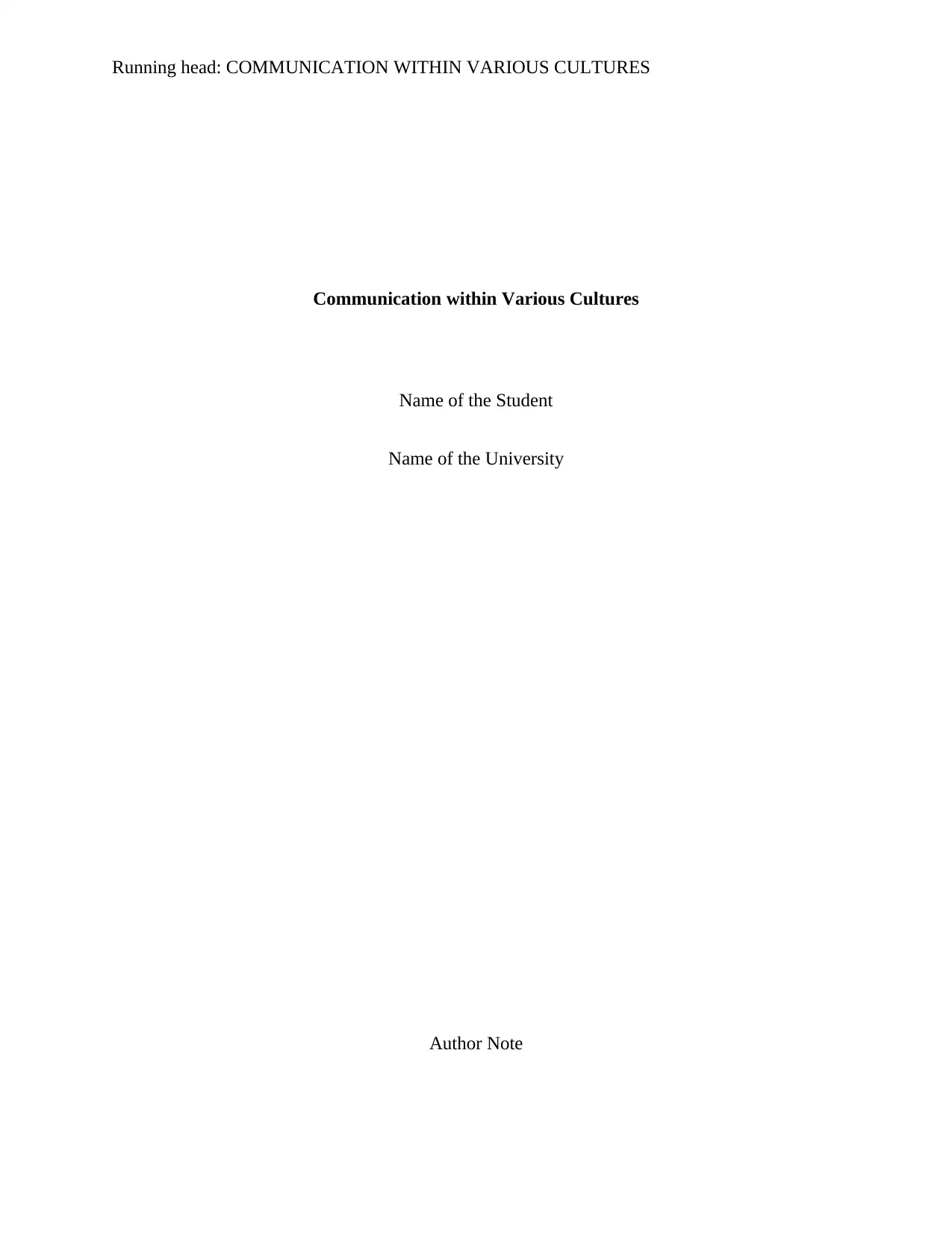
Running head: COMMUNICATION WITHIN VARIOUS CULTURES
Communication within Various Cultures
Name of the Student
Name of the University
Author Note
Communication within Various Cultures
Name of the Student
Name of the University
Author Note
Paraphrase This Document
Need a fresh take? Get an instant paraphrase of this document with our AI Paraphraser

1
COMMUNICATION WITHIN VARIOUS CULTURES
Table of Contents
Case study of the intercultural communication...............................................................................2
References........................................................................................................................................6
COMMUNICATION WITHIN VARIOUS CULTURES
Table of Contents
Case study of the intercultural communication...............................................................................2
References........................................................................................................................................6
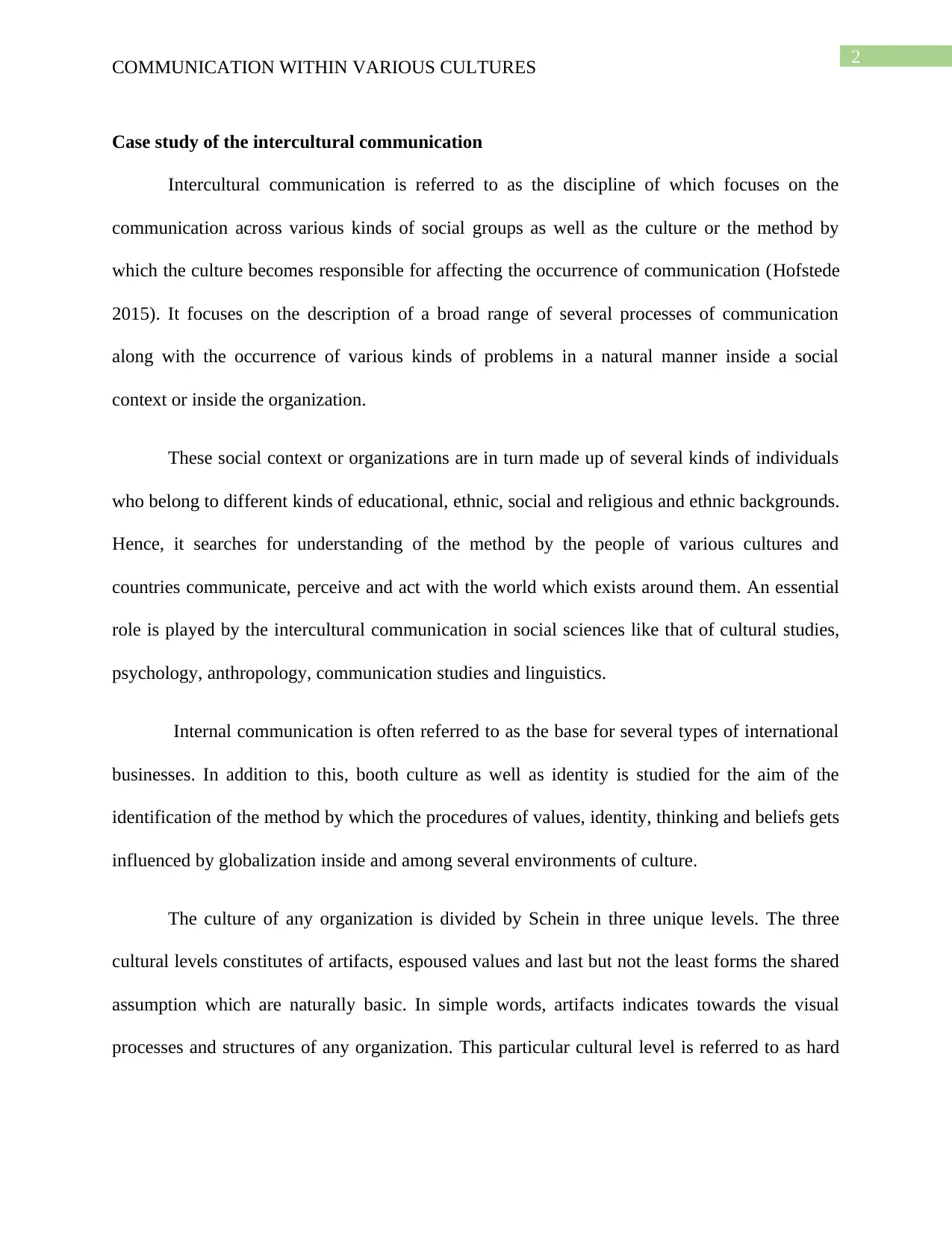
2
COMMUNICATION WITHIN VARIOUS CULTURES
Case study of the intercultural communication
Intercultural communication is referred to as the discipline of which focuses on the
communication across various kinds of social groups as well as the culture or the method by
which the culture becomes responsible for affecting the occurrence of communication (Hofstede
2015). It focuses on the description of a broad range of several processes of communication
along with the occurrence of various kinds of problems in a natural manner inside a social
context or inside the organization.
These social context or organizations are in turn made up of several kinds of individuals
who belong to different kinds of educational, ethnic, social and religious and ethnic backgrounds.
Hence, it searches for understanding of the method by the people of various cultures and
countries communicate, perceive and act with the world which exists around them. An essential
role is played by the intercultural communication in social sciences like that of cultural studies,
psychology, anthropology, communication studies and linguistics.
Internal communication is often referred to as the base for several types of international
businesses. In addition to this, booth culture as well as identity is studied for the aim of the
identification of the method by which the procedures of values, identity, thinking and beliefs gets
influenced by globalization inside and among several environments of culture.
The culture of any organization is divided by Schein in three unique levels. The three
cultural levels constitutes of artifacts, espoused values and last but not the least forms the shared
assumption which are naturally basic. In simple words, artifacts indicates towards the visual
processes and structures of any organization. This particular cultural level is referred to as hard
COMMUNICATION WITHIN VARIOUS CULTURES
Case study of the intercultural communication
Intercultural communication is referred to as the discipline of which focuses on the
communication across various kinds of social groups as well as the culture or the method by
which the culture becomes responsible for affecting the occurrence of communication (Hofstede
2015). It focuses on the description of a broad range of several processes of communication
along with the occurrence of various kinds of problems in a natural manner inside a social
context or inside the organization.
These social context or organizations are in turn made up of several kinds of individuals
who belong to different kinds of educational, ethnic, social and religious and ethnic backgrounds.
Hence, it searches for understanding of the method by the people of various cultures and
countries communicate, perceive and act with the world which exists around them. An essential
role is played by the intercultural communication in social sciences like that of cultural studies,
psychology, anthropology, communication studies and linguistics.
Internal communication is often referred to as the base for several types of international
businesses. In addition to this, booth culture as well as identity is studied for the aim of the
identification of the method by which the procedures of values, identity, thinking and beliefs gets
influenced by globalization inside and among several environments of culture.
The culture of any organization is divided by Schein in three unique levels. The three
cultural levels constitutes of artifacts, espoused values and last but not the least forms the shared
assumption which are naturally basic. In simple words, artifacts indicates towards the visual
processes and structures of any organization. This particular cultural level is referred to as hard
⊘ This is a preview!⊘
Do you want full access?
Subscribe today to unlock all pages.

Trusted by 1+ million students worldwide
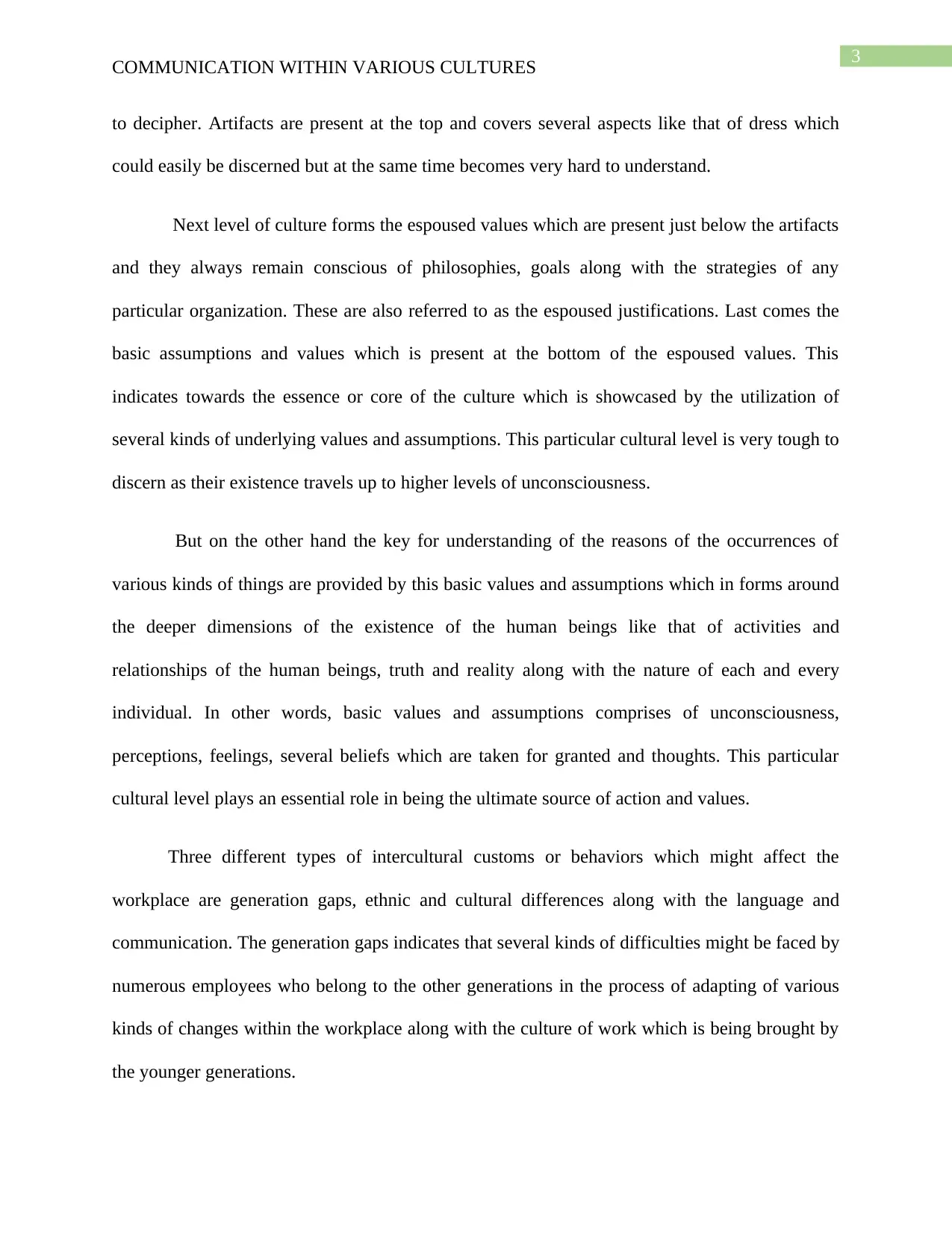
3
COMMUNICATION WITHIN VARIOUS CULTURES
to decipher. Artifacts are present at the top and covers several aspects like that of dress which
could easily be discerned but at the same time becomes very hard to understand.
Next level of culture forms the espoused values which are present just below the artifacts
and they always remain conscious of philosophies, goals along with the strategies of any
particular organization. These are also referred to as the espoused justifications. Last comes the
basic assumptions and values which is present at the bottom of the espoused values. This
indicates towards the essence or core of the culture which is showcased by the utilization of
several kinds of underlying values and assumptions. This particular cultural level is very tough to
discern as their existence travels up to higher levels of unconsciousness.
But on the other hand the key for understanding of the reasons of the occurrences of
various kinds of things are provided by this basic values and assumptions which in forms around
the deeper dimensions of the existence of the human beings like that of activities and
relationships of the human beings, truth and reality along with the nature of each and every
individual. In other words, basic values and assumptions comprises of unconsciousness,
perceptions, feelings, several beliefs which are taken for granted and thoughts. This particular
cultural level plays an essential role in being the ultimate source of action and values.
Three different types of intercultural customs or behaviors which might affect the
workplace are generation gaps, ethnic and cultural differences along with the language and
communication. The generation gaps indicates that several kinds of difficulties might be faced by
numerous employees who belong to the other generations in the process of adapting of various
kinds of changes within the workplace along with the culture of work which is being brought by
the younger generations.
COMMUNICATION WITHIN VARIOUS CULTURES
to decipher. Artifacts are present at the top and covers several aspects like that of dress which
could easily be discerned but at the same time becomes very hard to understand.
Next level of culture forms the espoused values which are present just below the artifacts
and they always remain conscious of philosophies, goals along with the strategies of any
particular organization. These are also referred to as the espoused justifications. Last comes the
basic assumptions and values which is present at the bottom of the espoused values. This
indicates towards the essence or core of the culture which is showcased by the utilization of
several kinds of underlying values and assumptions. This particular cultural level is very tough to
discern as their existence travels up to higher levels of unconsciousness.
But on the other hand the key for understanding of the reasons of the occurrences of
various kinds of things are provided by this basic values and assumptions which in forms around
the deeper dimensions of the existence of the human beings like that of activities and
relationships of the human beings, truth and reality along with the nature of each and every
individual. In other words, basic values and assumptions comprises of unconsciousness,
perceptions, feelings, several beliefs which are taken for granted and thoughts. This particular
cultural level plays an essential role in being the ultimate source of action and values.
Three different types of intercultural customs or behaviors which might affect the
workplace are generation gaps, ethnic and cultural differences along with the language and
communication. The generation gaps indicates that several kinds of difficulties might be faced by
numerous employees who belong to the other generations in the process of adapting of various
kinds of changes within the workplace along with the culture of work which is being brought by
the younger generations.
Paraphrase This Document
Need a fresh take? Get an instant paraphrase of this document with our AI Paraphraser
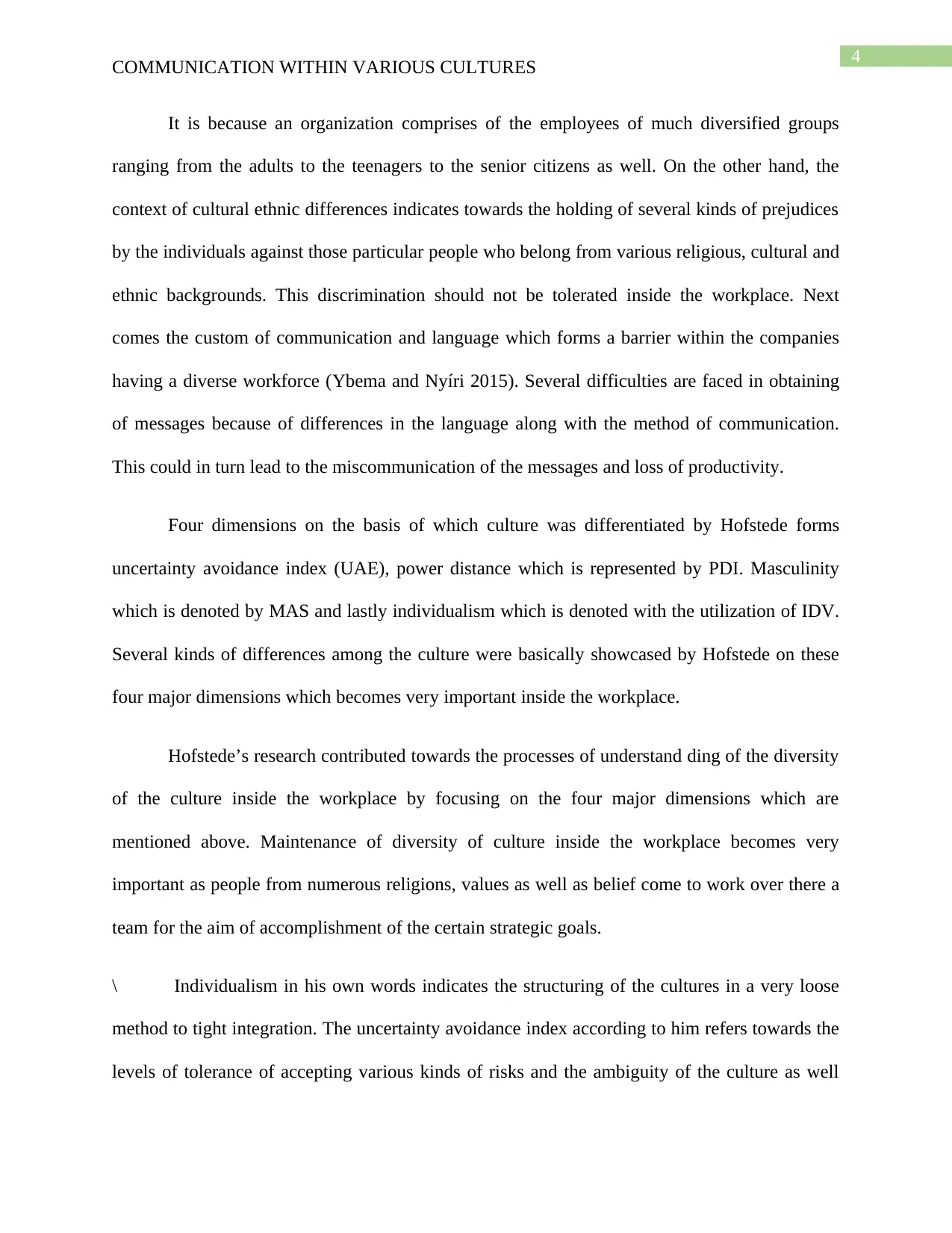
4
COMMUNICATION WITHIN VARIOUS CULTURES
It is because an organization comprises of the employees of much diversified groups
ranging from the adults to the teenagers to the senior citizens as well. On the other hand, the
context of cultural ethnic differences indicates towards the holding of several kinds of prejudices
by the individuals against those particular people who belong from various religious, cultural and
ethnic backgrounds. This discrimination should not be tolerated inside the workplace. Next
comes the custom of communication and language which forms a barrier within the companies
having a diverse workforce (Ybema and Nyíri 2015). Several difficulties are faced in obtaining
of messages because of differences in the language along with the method of communication.
This could in turn lead to the miscommunication of the messages and loss of productivity.
Four dimensions on the basis of which culture was differentiated by Hofstede forms
uncertainty avoidance index (UAE), power distance which is represented by PDI. Masculinity
which is denoted by MAS and lastly individualism which is denoted with the utilization of IDV.
Several kinds of differences among the culture were basically showcased by Hofstede on these
four major dimensions which becomes very important inside the workplace.
Hofstede’s research contributed towards the processes of understand ding of the diversity
of the culture inside the workplace by focusing on the four major dimensions which are
mentioned above. Maintenance of diversity of culture inside the workplace becomes very
important as people from numerous religions, values as well as belief come to work over there a
team for the aim of accomplishment of the certain strategic goals.
\ Individualism in his own words indicates the structuring of the cultures in a very loose
method to tight integration. The uncertainty avoidance index according to him refers towards the
levels of tolerance of accepting various kinds of risks and the ambiguity of the culture as well
COMMUNICATION WITHIN VARIOUS CULTURES
It is because an organization comprises of the employees of much diversified groups
ranging from the adults to the teenagers to the senior citizens as well. On the other hand, the
context of cultural ethnic differences indicates towards the holding of several kinds of prejudices
by the individuals against those particular people who belong from various religious, cultural and
ethnic backgrounds. This discrimination should not be tolerated inside the workplace. Next
comes the custom of communication and language which forms a barrier within the companies
having a diverse workforce (Ybema and Nyíri 2015). Several difficulties are faced in obtaining
of messages because of differences in the language along with the method of communication.
This could in turn lead to the miscommunication of the messages and loss of productivity.
Four dimensions on the basis of which culture was differentiated by Hofstede forms
uncertainty avoidance index (UAE), power distance which is represented by PDI. Masculinity
which is denoted by MAS and lastly individualism which is denoted with the utilization of IDV.
Several kinds of differences among the culture were basically showcased by Hofstede on these
four major dimensions which becomes very important inside the workplace.
Hofstede’s research contributed towards the processes of understand ding of the diversity
of the culture inside the workplace by focusing on the four major dimensions which are
mentioned above. Maintenance of diversity of culture inside the workplace becomes very
important as people from numerous religions, values as well as belief come to work over there a
team for the aim of accomplishment of the certain strategic goals.
\ Individualism in his own words indicates the structuring of the cultures in a very loose
method to tight integration. The uncertainty avoidance index according to him refers towards the
levels of tolerance of accepting various kinds of risks and the ambiguity of the culture as well
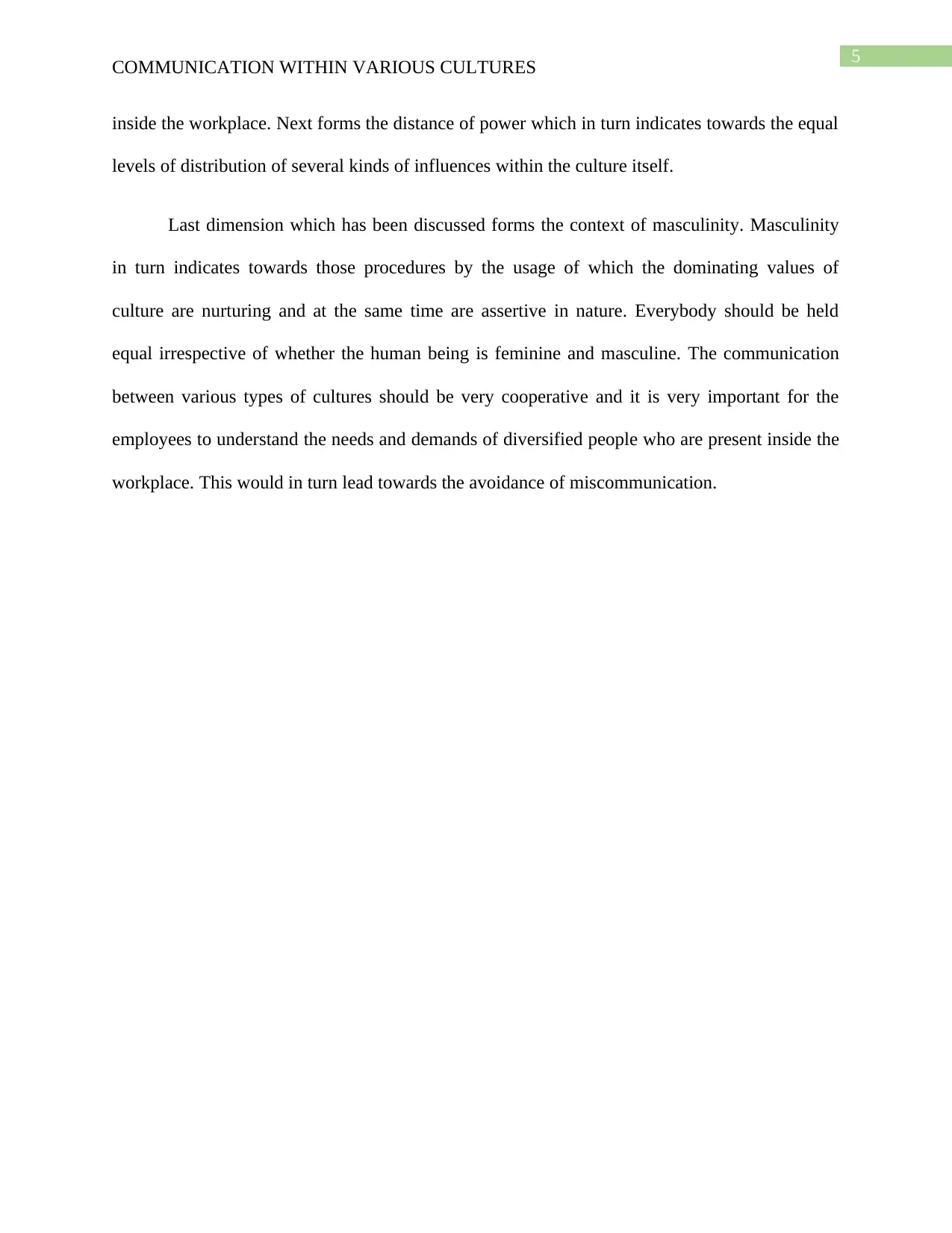
5
COMMUNICATION WITHIN VARIOUS CULTURES
inside the workplace. Next forms the distance of power which in turn indicates towards the equal
levels of distribution of several kinds of influences within the culture itself.
Last dimension which has been discussed forms the context of masculinity. Masculinity
in turn indicates towards those procedures by the usage of which the dominating values of
culture are nurturing and at the same time are assertive in nature. Everybody should be held
equal irrespective of whether the human being is feminine and masculine. The communication
between various types of cultures should be very cooperative and it is very important for the
employees to understand the needs and demands of diversified people who are present inside the
workplace. This would in turn lead towards the avoidance of miscommunication.
COMMUNICATION WITHIN VARIOUS CULTURES
inside the workplace. Next forms the distance of power which in turn indicates towards the equal
levels of distribution of several kinds of influences within the culture itself.
Last dimension which has been discussed forms the context of masculinity. Masculinity
in turn indicates towards those procedures by the usage of which the dominating values of
culture are nurturing and at the same time are assertive in nature. Everybody should be held
equal irrespective of whether the human being is feminine and masculine. The communication
between various types of cultures should be very cooperative and it is very important for the
employees to understand the needs and demands of diversified people who are present inside the
workplace. This would in turn lead towards the avoidance of miscommunication.
⊘ This is a preview!⊘
Do you want full access?
Subscribe today to unlock all pages.

Trusted by 1+ million students worldwide
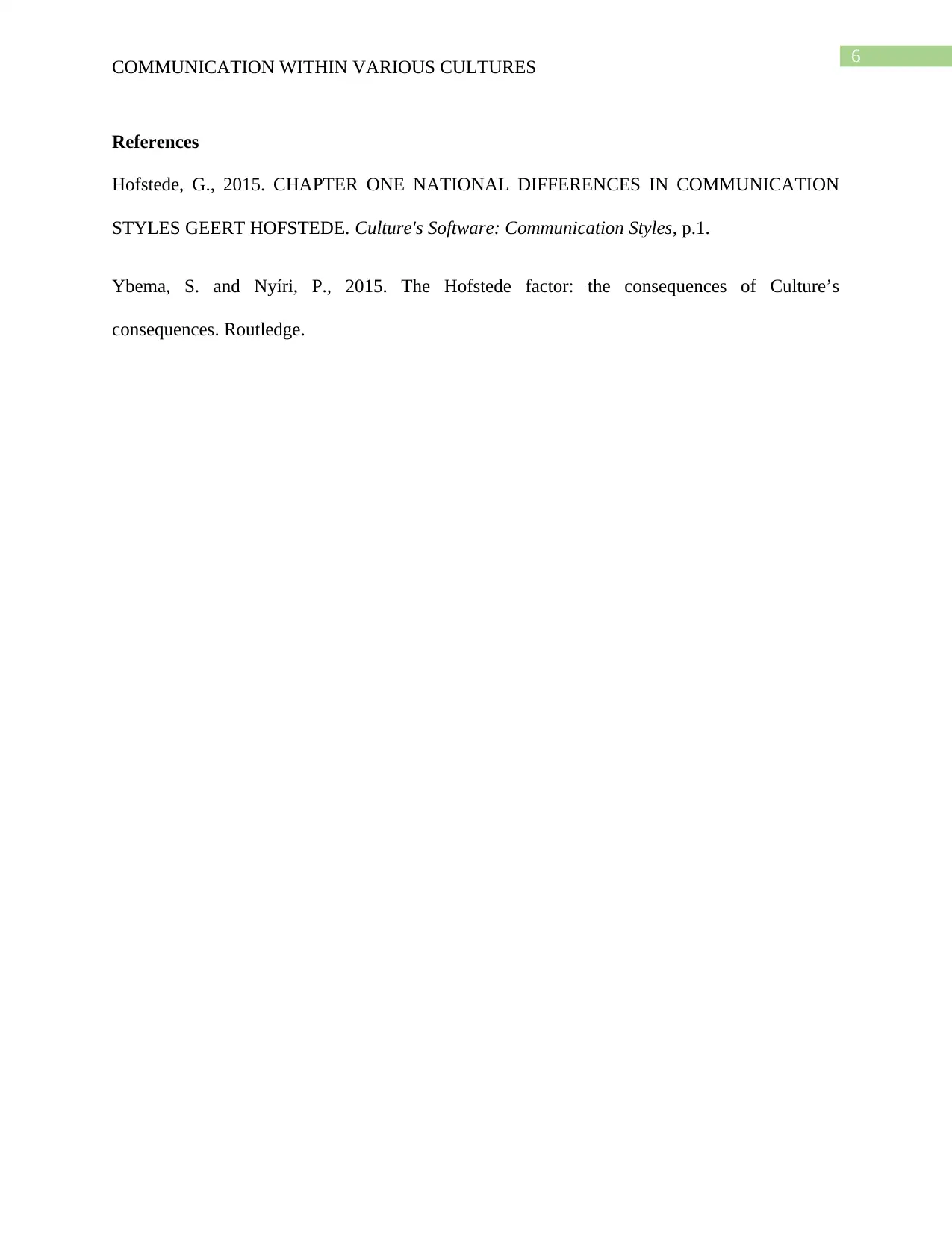
6
COMMUNICATION WITHIN VARIOUS CULTURES
References
Hofstede, G., 2015. CHAPTER ONE NATIONAL DIFFERENCES IN COMMUNICATION
STYLES GEERT HOFSTEDE. Culture's Software: Communication Styles, p.1.
Ybema, S. and Nyíri, P., 2015. The Hofstede factor: the consequences of Culture’s
consequences. Routledge.
COMMUNICATION WITHIN VARIOUS CULTURES
References
Hofstede, G., 2015. CHAPTER ONE NATIONAL DIFFERENCES IN COMMUNICATION
STYLES GEERT HOFSTEDE. Culture's Software: Communication Styles, p.1.
Ybema, S. and Nyíri, P., 2015. The Hofstede factor: the consequences of Culture’s
consequences. Routledge.
1 out of 7
Related Documents
Your All-in-One AI-Powered Toolkit for Academic Success.
+13062052269
info@desklib.com
Available 24*7 on WhatsApp / Email
![[object Object]](/_next/static/media/star-bottom.7253800d.svg)
Unlock your academic potential
Copyright © 2020–2025 A2Z Services. All Rights Reserved. Developed and managed by ZUCOL.





